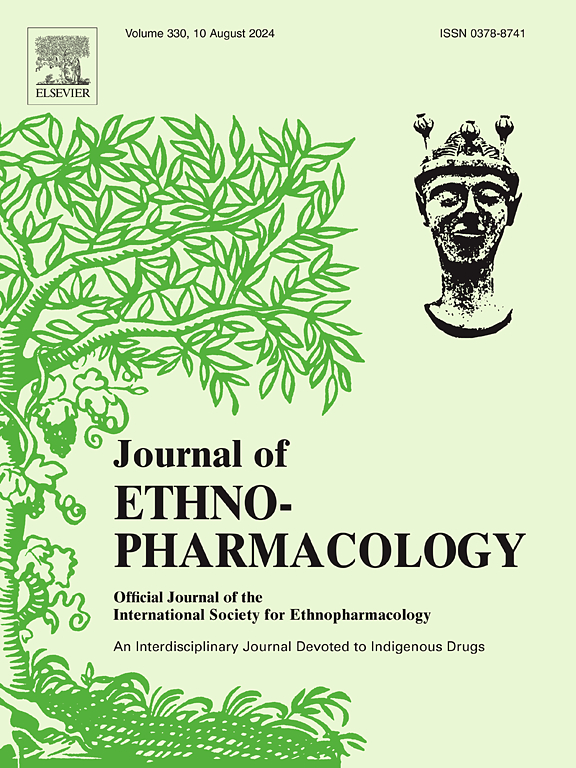In vitro antimicrobial activities and phytochemical profiling of Cananga odorata, Terminalia catappa, and Terminalia mantaly
IF 5.4
2区 医学
Q1 CHEMISTRY, MEDICINAL
引用次数: 0
Abstract
Ethnomedicinal relevance
Cananga odorata, Terminalia catappa, and Terminalia mantaly are widely used in traditional medicine in Cameroon to treat several illnesses, like diarrhoea, gastroenteritis, genital candidiasis, and oral candidiasis.
Aim of the study
This study aimed to investigate the antimicrobial, antibiofilm activities and phytochemical profiling of extracts from three medicinal plants C. odorata, T. catappa, and T. mantaly from Cameroon.
Materials and methods
Crude ethanol, hydro-ethanol, and water extracts of the three selected Cameroonian medicinal plants were prepared and tested against 9 bacteria and 4 yeast strains in vitro. The most active extract was selected for further evaluation, including antibiofilm activities, time-kill kinetics, nucleic acid leakage, salt tolerance on Pseudomonas aeruginosa and Candida albicans, as well as antioxidant and cytotoxicity on Raw and Vero cells. Additionally, morphological cell disruption observations using scanning electron microscopy and GC-MS analysis were conducted.
Results
Out of 36 extracts tested, 23 showed activities against bacteria and 12 against yeasts, with MIC values ranging from 62.5 μg/mL to 1000 μg/mL. The most effective extract was the ethanolic extract of T. mantaly stem bark (TMb EtOH), which demonstrated broad-spectrum antimicrobial activity against P. aeruginosa (MIC 250 μg/mL) and C. albicans (MIC 62.5 μg/mL), through nucleotide leakage and salt tolerance tests. TMb EtOH also exhibited significant antioxidant activity (IC50 of 17.83 ± 1.25, 17.41 ± 1.24, and 27.66 ± 1.442 μg/mL on DPPH, ABTS, and FRAP, respectively) and low toxicity on Raw and Vero cells (CC50 of 168.55 ± 3.32 and 439.85 ± 16.47 μg/mL, respectively). Scanning electron micrographs confirmed the ability of TMb EtOH to interact, destabilise, and disrupt microbial cell walls, as evidenced by the multiple deflations, depressions and indentations. Furthermore, GC-MS analysis identified 37 compounds in the extract, with betulin (13.11 %) being the most predominant compound, well-known for its antimicrobial and antioxidant properties.
Conclusion
This study highlights the potential of the ethanolic extract of T. mantaly stem bark as a promising source of antimicrobial compounds. The bio-guided fractionation of TMb EtOH is ongoing to isolate and purify these compounds for drug discovery purposes.

加南加、加南加、加南加的体外抑菌活性及植物化学分析。
民族医学相关性:喀麦隆的传统医学广泛使用加南加、加南加和加南加来治疗多种疾病,如腹泻、肠胃炎、生殖器念珠菌病和口腔念珠菌病。目的:研究喀麦隆三种药用植物C. odorata、T. catappa和T. mantaly提取物的抑菌活性、抗生物膜活性和植物化学特征。材料与方法:制备3种喀麦隆药用植物的粗乙醇、氢乙醇和水提取物,并对9种细菌和4株酵母菌进行体外抑菌试验。选择最具活性的提取物进行进一步评价,包括抗生物膜活性、时间杀伤动力学、核酸泄漏、对铜绿假单胞菌和白色念珠菌的耐盐性、对Raw和Vero细胞的抗氧化和细胞毒性。此外,利用扫描电镜和气相色谱-质谱分析进行了形态学细胞破坏观察。结果:36个提取物中,23个具有抑菌活性,12个具有抑菌活性,其MIC值在62.5 ~ 1000 μg/mL之间。通过核苷酸泄漏试验和耐盐试验,结果表明,对铜绿假单胞菌(MIC为250 μg/mL)和白色假单胞菌(MIC为62.5 μg/mL)具有广谱抗菌活性,效果最好的提取物为藤茎皮乙醇提取物(TMb EtOH)。TMb EtOH对DPPH、ABTS和FRAP具有显著的抗氧化活性(IC50分别为17.83±1.25、17.41±1.24和27.66±1.442 μg/mL),对Raw和Vero细胞具有低毒性(CC50分别为168.55±3.32和439.85±16.47 μg/mL)。扫描电子显微照片证实了TMb EtOH能够相互作用,破坏微生物细胞壁的稳定性,如多重收缩、凹陷和凹痕。此外,GC-MS分析在提取物中鉴定出37种化合物,其中以抗菌和抗氧化特性闻名的白桦素(13.11%)为最主要的化合物。结论:该研究强调了大黄茎皮乙醇提取物作为抗菌化合物的潜在来源。生物引导分离TMb EtOH正在进行中,以分离和纯化这些化合物,用于药物发现目的。
本文章由计算机程序翻译,如有差异,请以英文原文为准。
求助全文
约1分钟内获得全文
求助全文
来源期刊

Journal of ethnopharmacology
医学-全科医学与补充医学
CiteScore
10.30
自引率
5.60%
发文量
967
审稿时长
77 days
期刊介绍:
The Journal of Ethnopharmacology is dedicated to the exchange of information and understandings about people''s use of plants, fungi, animals, microorganisms and minerals and their biological and pharmacological effects based on the principles established through international conventions. Early people confronted with illness and disease, discovered a wealth of useful therapeutic agents in the plant and animal kingdoms. The empirical knowledge of these medicinal substances and their toxic potential was passed on by oral tradition and sometimes recorded in herbals and other texts on materia medica. Many valuable drugs of today (e.g., atropine, ephedrine, tubocurarine, digoxin, reserpine) came into use through the study of indigenous remedies. Chemists continue to use plant-derived drugs (e.g., morphine, taxol, physostigmine, quinidine, emetine) as prototypes in their attempts to develop more effective and less toxic medicinals.
 求助内容:
求助内容: 应助结果提醒方式:
应助结果提醒方式:


